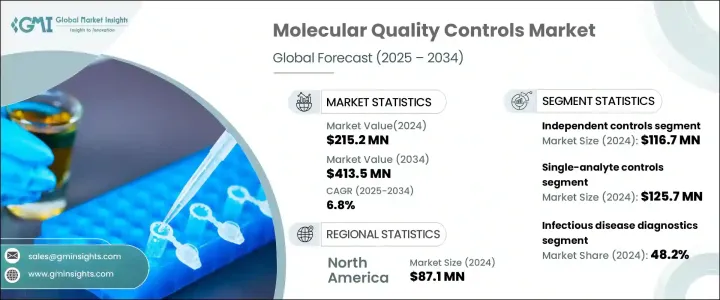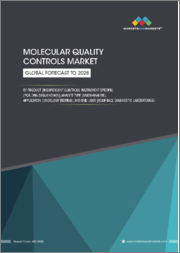
|
시장보고서
상품코드
1698243
분자 품질 관리 시장 : 시장 기회, 성장 촉진요인, 산업 동향 분석, 예측(2025-2034년)Molecular Quality Controls Market Opportunity, Growth Drivers, Industry Trend Analysis, and Forecast 2025-2034 |
||||||
세계의 분자 품질 관리 시장은 2024년 2억 1,520만 달러로 평가되었으며, 2025-2034년 연평균 복합 성장률(CAGR) 6.8%로 확대될 것으로 예측됩니다.
분자 품질 관리는 분자진단에 필수적인 표준 물질로 작용하며 검사 결과의 정확성, 일관성, 신뢰성을 보장합니다. 이러한 컨트롤은 분석 성능 모니터링, 잠재적 오류 파악, 엄격한 규제 가이드라인 준수를 지원함으로써 검사실에서 중요한 역할을 하고 있습니다. 헬스케어 공급자들이 감염, 암 검출, 유전자 분석을 위해 분자 검사에 대한 의존도를 높이면서 정밀한 진단 솔루션에 대한 수요 증가가 시장 확대의 주요 요인이 되고 있습니다. 게다가 감염증 및 유전성 질환의 이환율 증가가, 분자 진단에서 계속적인 진보의 필요성을 높이고 있습니다.

2023년 분자 품질 관리 시장은 2억 350만 달러로 평가되었습니다. 제품 유형에 따라 시장은 독립 컨트롤 및 장치별 컨트롤로 분류됩니다. 독립 컨트롤 분야는 2024년 1억 1,670만 달러의 매출을 기록하였고, 2034년까지 CAGR 6.7%로 성장할 것으로 예측되고 있습니다. 독립 컨트롤은 검사 키트와는 별도로 제조되어 분자 분석 성능의 객관적 평가를 가능하게 합니다. 이러한 컨트롤은 검사실이 배치 간 편차, 시약 불안정성, 장치 오류를 검출하는 데 도움이 되며 신뢰성 있고 일관된 결과를 보장합니다. 또한 규제 기준을 충족시키기 위해 중요한 외부 품질 평가 프로그램과 기능 시험도 지원합니다.
| 시장 범위 | |
|---|---|
| 시작 연도 | 2024년 |
| 예측 연도 | 2025-2034년 |
| 시작 금액 | 2억 1,520만 달러 |
| 예측 금액 | 4억 1,350만 달러 |
| CAGR | 6.8% |
분석물 유형별로 시장은 단일 분석물 컨트롤과 다중 분석물 컨트롤로 구분됩니다. 단일 분석물 컨트롤 부문은 2024년 시장 점유율의 58.4%를 차지했으며, 1억 2,570만 달러의 수익을 창출했습니다. 이러한 컨트롤은 특정 표적 분석물의 정확한 모니터링을 가능하게 하고 다항목 컨트롤과 관련된 교차 반응 위험을 최소화합니다. 안정성이 높아 장기간에 걸쳐 안정적인 성능을 발휘하며, 어세이의 편차를 억제하여 분자 검사의 품질 보증을 지원합니다.
용도별로 시장은 감염증 진단, 암 검사, 유전자 검사, 기타 분야로 나뉩니다. 감염증 진단 분야는 2024년에 시장의 48.2%를 차지했습니다. 분자 진단약은 증상이 나타나기 전이라도 병원체의 조기발견에 중요한 역할을 하고 있습니다. 분자 품질 관리는 잠재적인 시약의 열화 및 어세이의 실패를 조기에 검출하는 메커니즘으로서 기능함으로써 이러한 신속 어세이의 정밀도를 장기간에 걸쳐 확보하기 위해 필수적입니다.
시장은 최종 용도에 근거해, 병원, 진단 랩, 학술 및 연구 기관, 수탁 연구 기관, 기타 사용자로 구분됩니다. 진단 랩 부문은 2024년 총 매출의 34.5%를 차지했습니다. 이들 랩은 감염병, 종양, 유전성 질환 등의 분자 검사를 대량으로 취급하고 있어 분자 품질 관리의 주요한 채용자가 되고 있습니다.
북미의 2024년 매출은 8,710만 달러로 평가되었고, 2034년에는 1억 6,470만 달러에 달할 것으로 예상되고 있습니다. 미국은 2023년에 7,550만 달러의 수익으로 이 지역을 리드했습니다. 이 나라에 있어서 감염증 및 암의 유병률의 증가는, 분자 진단 검사의 정확도를 보증하는 엄격한 FDA 규제와 함께, 분자 품질 관리의 수요를 촉진하는 주요인입니다.
목차
제1장 조사 방법 및 조사 범위
제2장 주요 요약
제3장 업계 인사이트
- 생태계 분석
- 업계에 미치는 영향요인
- 성장 촉진요인
- 암 및 감염증 증가
- 분자 진단 채용 확대
- 분자 진단 기술적 진보
- 정확한 진단 검사에 대한 수요 증가
- 업계의 잠재적 위험 및 과제
- 분자 품질 관리 서비스의 고비용
- 한정된 상환정책
- 성장 촉진요인
- 성장 가능성 분석
- 규제 상황
- 기술적 전망
- 향후 시장 동향
- Porter's Five Forces 분석
- PESTEL 분석
제4장 경쟁 구도
- 서문
- 기업 점유율 분석
- 기업 매트릭스 분석
- 주요 시장 기업의 경쟁 분석
- 경쟁 포지셔닝 매트릭스
- 전략 대시보드
제5장 시장 추계 및 예측 : 제품별(2021-2034년)
- 주요 동향
- 독립제어기기
- 기기 특이적 컨트롤
- 중합효소 연쇄반응
- DNA 시퀀싱 및 NGS
- 기타 장치별 컨트롤
제6장 시장 추계 및 예측 : 분석물 유형별(2021-2034년)
- 주요 동향
- 단일 분석물 컨트롤
- 복수 분석물 컨트롤
제7장 시장 추계 및 예측 : 용도별(2021-2034년)
- 주요 동향
- 감염증 진단
- 종양학 검사
- 유전자 검사
- 기타 용도
제8장 시장 추계 및 예측 : 최종 용도별(2021-2034년)
- 주요 동향
- 병원
- 진단 실험실
- 학술기관 및 연구기관
- 수탁연구기관
- 기타 최종 용도
제9장 시장 추계 및 예측 : 지역별(2021-2034년)
- 주요 동향
- 북미
- 미국
- 캐나다
- 유럽
- 독일
- 영국
- 프랑스
- 스페인
- 이탈리아
- 네덜란드
- 아시아태평양
- 중국
- 일본
- 인도
- 호주
- 한국
- 라틴아메리카
- 브라질
- 멕시코
- 아르헨티나
- 중동 및 아프리카
- 남아프리카
- 사우디아라비아
- 아랍에미리트(UAE)
제10장 기업 프로파일
- Anchor Molecular
- Bio-Rad Laboratories
- Bio-Techne Corporation
- Fortress Diagnostics
- Microbiologics
- Microbix Biosystems
- Maine Molecular Quality Controls
- Quidelortho Corporation
- Qiagen
- Randox Laboratories
- Seegene
- Thermo Fisher Scientific
- Zeptometrix
The Global Molecular Quality Controls Market was valued at USD 215.2 million in 2024 and is projected to expand at a CAGR of 6.8% from 2025 to 2034. Molecular quality controls serve as essential reference materials in molecular diagnostics, ensuring accuracy, consistency, and reliability in test results. These controls play a critical role in laboratories by helping monitor assay performance, identify potential errors, and comply with stringent regulatory guidelines. The rising demand for precise diagnostic solutions is a major factor fueling market expansion, as healthcare providers increasingly rely on molecular testing for infectious diseases, cancer detection, and genetic analysis. Additionally, the growing incidence of infectious diseases and genetic disorders has amplified the need for continuous advancements in molecular diagnostics.

In 2023, the molecular quality controls market was valued at USD 203.5 million. Based on product type, the market is categorized into independent controls and instrument-specific controls. The independent controls segment held USD 116.7 million in revenue in 2024 and is projected to grow at a CAGR of 6.7% through 2034. Independent controls are manufactured separately from test kits, enabling objective evaluation of molecular assay performance. These controls help laboratories detect batch-to-batch variations, reagent instability, and instrument malfunctions, ensuring reliable and consistent results. They also support external quality assessment programs and proficiency testing, which are crucial for meeting regulatory standards.
| Market Scope | |
|---|---|
| Start Year | 2024 |
| Forecast Year | 2025-2034 |
| Start Value | $215.2 Million |
| Forecast Value | $413.5 Million |
| CAGR | 6.8% |
By analyte type, the market is segmented into single-analyte and multi-analyte controls. The single-analyte controls segment accounted for 58.4% of the market share in 2024, generating USD 125.7 million in revenue. These controls allow for precise monitoring of specific target analytes, minimizing cross-reactivity risks associated with multi-analyte controls. Their high stability ensures consistent performance over time, reducing assay variability and supporting quality assurance in molecular testing.
In terms of application, the market is divided into infectious disease diagnostics, oncology testing, genetic testing, and other areas. The infectious disease diagnostics segment held 48.2% of the market in 2024. Molecular diagnostics play a crucial role in early pathogen detection, even before symptoms manifest. Molecular quality controls are essential in ensuring the accuracy of these rapid assays over time by serving as an early detection mechanism for potential reagent degradation or assay failures.
Based on end use, the market is segmented into hospitals, diagnostic laboratories, academic and research institutes, contract research organizations, and other users. The diagnostic laboratories segment accounted for 34.5% of total revenue in 2024. These laboratories handle large volumes of molecular tests for infectious diseases, oncology, and genetic disorders, making them primary adopters of molecular quality controls.
North America accounted for USD 87.1 million in revenue in 2024 and is expected to reach USD 164.7 million by 2034. The US led the region with USD 75.5 million in revenue in 2023. The increasing prevalence of infectious diseases and cancer in the country is a key factor driving demand for molecular quality controls, alongside stringent FDA regulations ensuring the accuracy of molecular diagnostic tests.
Table of Contents
Chapter 1 Methodology and Scope
- 1.1 Market scope and definitions
- 1.2 Research design
- 1.2.1 Research approach
- 1.2.2 Data collection methods
- 1.3 Base estimates and calculations
- 1.3.1 Base year calculation
- 1.3.2 Key trends for market estimation
- 1.4 Forecast model
- 1.5 Primary research and validation
- 1.5.1 Primary sources
- 1.5.2 Data mining sources
Chapter 2 Executive Summary
- 2.1 Industry 360° synopsis
Chapter 3 Industry Insights
- 3.1 Industry ecosystem analysis
- 3.2 Industry impact forces
- 3.2.1 Growth drivers
- 3.2.1.1 Rising prevalence of cancers and infectious diseases
- 3.2.1.2 Growing adoption of molecular diagnostics
- 3.2.1.3 Technological advancements in molecular diagnostics
- 3.2.1.4 Rising demand for accurate diagnostics testing
- 3.2.2 Industry pitfalls and challenges
- 3.2.2.1 High cost of molecular quality control services
- 3.2.2.2 Limited reimbursement policies
- 3.2.1 Growth drivers
- 3.3 Growth potential analysis
- 3.4 Regulatory landscape
- 3.5 Technological landscape
- 3.6 Future market trends
- 3.7 Porter's analysis
- 3.8 PESTEL analysis
Chapter 4 Competitive Landscape, 2024
- 4.1 Introduction
- 4.2 Company market share analysis
- 4.3 Company matrix analysis
- 4.4 Competitive analysis of major market players
- 4.5 Competitive positioning matrix
- 4.6 Strategy dashboard
Chapter 5 Market Estimates and Forecast, By Product, 2021 – 2034 ($ Mn)
- 5.1 Key trends
- 5.2 Independent controls
- 5.3 Instrument-specific controls
- 5.3.1 Polymerase chain reaction
- 5.3.2 DNA sequencing and NGS
- 5.3.3 Other instrument-specific controls
Chapter 6 Market Estimates and Forecast, By Analyte Type, 2021 – 2034 ($ Mn)
- 6.1 Key trends
- 6.2 Single-analyte controls
- 6.3 Multi-analyte controls
Chapter 7 Market Estimates and Forecast, By Application, 2021 – 2034 ($ Mn)
- 7.1 Key trends
- 7.2 Infectious disease diagnostics
- 7.3 Oncology testing
- 7.4 Genetic testing
- 7.5 Other applications
Chapter 8 Market Estimates and Forecast, By End Use, 2021 – 2034 ($ Mn)
- 8.1 Key trends
- 8.2 Hospitals
- 8.3 Diagnostic laboratories
- 8.4 Academic and research institutes
- 8.5 Contract research organizations
- 8.6 Other end use
Chapter 9 Market Estimates and Forecast, By Region, 2021 – 2034 ($ Mn)
- 9.1 Key trends
- 9.2 North America
- 9.2.1 U.S.
- 9.2.2 Canada
- 9.3 Europe
- 9.3.1 Germany
- 9.3.2 UK
- 9.3.3 France
- 9.3.4 Spain
- 9.3.5 Italy
- 9.3.6 Netherlands
- 9.4 Asia Pacific
- 9.4.1 China
- 9.4.2 Japan
- 9.4.3 India
- 9.4.4 Australia
- 9.4.5 South Korea
- 9.5 Latin America
- 9.5.1 Brazil
- 9.5.2 Mexico
- 9.5.3 Argentina
- 9.6 Middle East and Africa
- 9.6.1 South Africa
- 9.6.2 Saudi Arabia
- 9.6.3 UAE
Chapter 10 Company Profiles
- 10.1 Anchor Molecular
- 10.2 Bio-Rad Laboratories
- 10.3 Bio-Techne Corporation
- 10.4 Fortress Diagnostics
- 10.5 Microbiologics
- 10.6 Microbix Biosystems
- 10.7 Maine Molecular Quality Controls
- 10.8 Quidelortho Corporation
- 10.9 Qiagen
- 10.10 Randox Laboratories
- 10.11 Seegene
- 10.12 Thermo Fisher Scientific
- 10.13 Zeptometrix
















